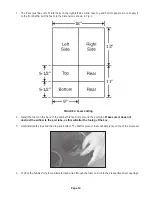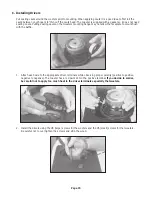
Most loudspeakers, including the BR-1, use drivers mounted on a flat baffle. One problem encountered here is the
fact that the tweeter’s relative acoustic center is set ahead of the woofer’s relative acoustic center. In general, a flush
mounted tweeter’s acoustic center is aligned with the front baffle. A typical 6-1/2" woofer’s relative acoustic center,
is set about 1-1/2" behind the tweeter. This means that when fed a signal at the crossover frequency, the woofer’s
output will be delayed 110uS relative to the tweeter. For successful filter summation, this must be dealt with.
The method used to compensate for this delay in the BR-1 is the use of asymmetrical filters. Normally one would use
the same crossover topology for both high pass and low pass filters. A 3
rd
order high pass acoustic slope is used with
a 2
nd
order low pass acoustic slope to allow for the time delay. This technique takes advantage of the phase delay
differences between the two filter types and results in a flat summation and allows both drivers to be acoustically in-
phase with one another at the crossover frequency.
The crossover filters were designed to achieve a flat overall response. The BR-1 measures on axis /- 2.0dB
from 100 Hz -12 KHz. Flat frequency response is desirable so that all frequencies are reproduced with the same
loudness over the loudspeaker’s bandwidth. In itself, flat frequency response does not ensure a good sounding loud-
speaker. But targeting flat on axis performance, is the first step in designing a high performance loudspeaker.
Another, arguably more important goal is flat off axis frequency response. Many times a speaker can measure flat on
axis, but the off axis curves suffer from dips in the response. This is due to insufficient driver overlap, usually caused
by using too high of a crossover point for the low frequency driver. Good off axis performance, will avoid the so-called
Venetian blind effect. What is the Venetian blind effect? When the seated listener moves horizontally from directly in
front of the speaker, the treble or high frequency response drops off dramatically. A loudspeaker which exhibits good
off axis response can be listened to well away from directly in front of the speakers and excellent performance will
still be enjoyed.
Note that even 60 degrees off axis, the woofer is producing a reasonably flat response without deep nulls or
cancellations throughout the crossover region.
Page 6
On/Off Axis Response of BR-1 System


































